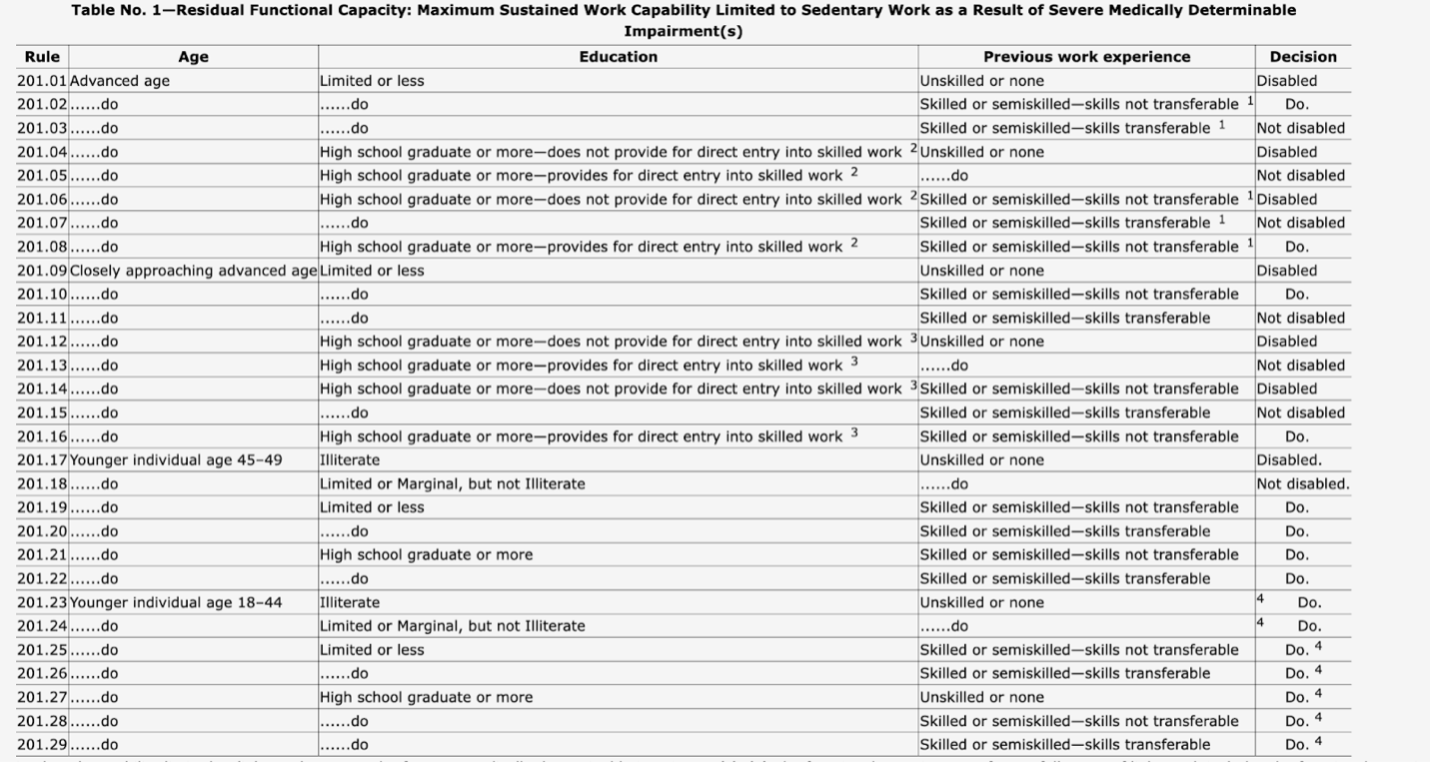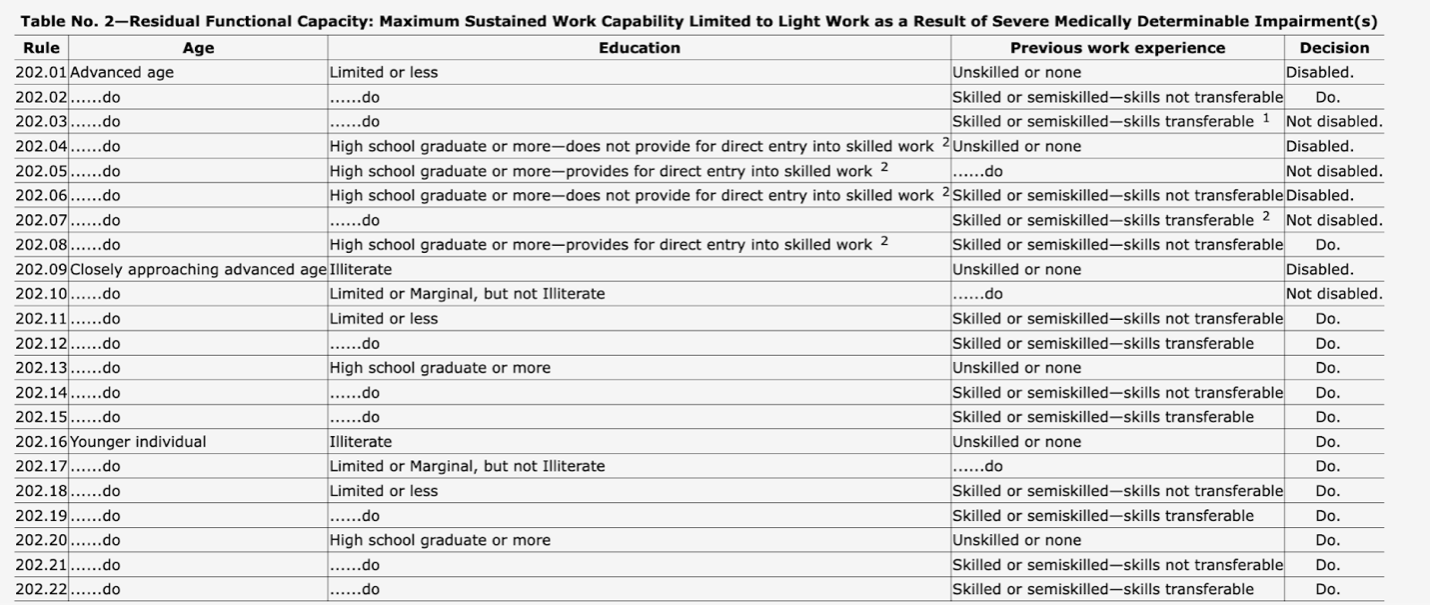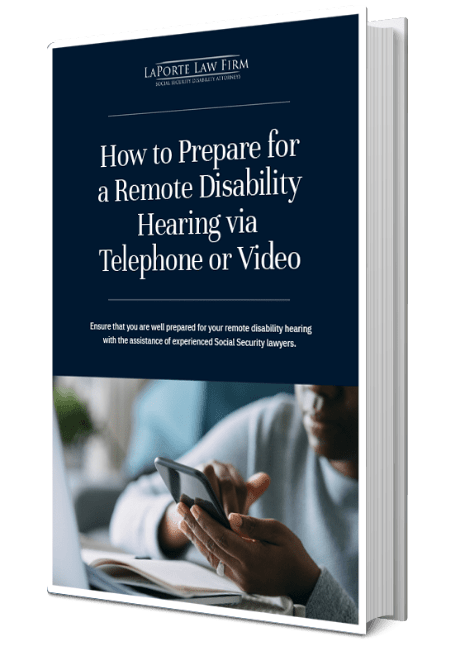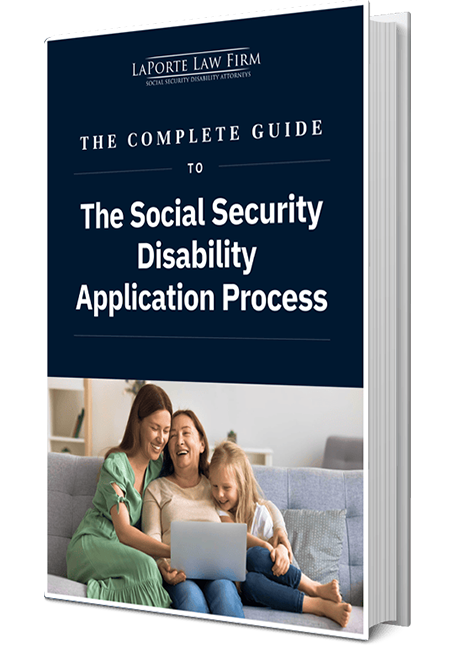
Are you applying for SSDI (Social Security Disability Insurance) benefits: Then there’s a set of SSA (Social Security Administration) rules you should know about: the GRID Rules. These refer to a set of guidelines the SSA uses to determine the eligibility of individuals applying for disability benefits. They consider your physical and mental limitations, age, education, and work history to assess whether you can work.
Familiarizing yourself with the GRID rules can help you better assess your eligibility for SSDI benefits and make informed decisions about your claim.
What are the Social Security GRID Rules?
The SSA’s GRID Rules considers factors such as your age, education, work experience, and what kind of work you are capable of performing given your physical and mental impairments. If you are incapable of performing any of the jobs you performed in the past five years, the GRID Rules may apply to your case if the SSA determines that you cannot perform other types of work in the national economy.
The type of work you are capable of performing is called your residual functional capacity (RFC), and your past relevant work is any work you have performed in the past five years. This formula is called a medical-vocational profile, since it considers both your work history and your medical disabilities. Certain combinations of these medical-vocational factors result in a finding of disability, while certain medical-vocational profiles result in a denial decision. In general, the GRID Rules are advantageous to disability claimants who are over the age of 50, and even more favorable to people over age 55.
How the Social Security GRID Rules Work
The GRID Rules can impact your disability claim in that the SSA applies them to:
Determine disability status
In many cases, the SSA will apply the GRID Rules to make a quick determination of your eligibility. If your specific combination of factors (age, education, work experience, and RFC) matches a category in the GRID Rules, the SSA will automatically approve or deny your claim.
To apply the GRID Rules, the SSA considers four key factors:
- Age: The SSA defines age categories under the GRID Rules as follows:
- Younger Individual: Age 18–49
- Closely Approaching Advanced Age: 50–54
- Advanced Age: 55–59
- Closely Approaching Retirement Age: 60 or older
For those closely approaching advanced age, of advanced age, or closely approaching retirement age, the SSA recognizes the general principle that it is harder for you to adjust to other work in the national economy that does not relate to your past relevant work.
- Work experience: The GRID Rules take into account the skills gained from past work, categorizing past relevant work as unskilled, semi-skilled, or skilled. The SSA maintains an old-school classification system for what is considered skilled work versus unskilled work. A person with past relevant work in a skilled office job will have a higher burden of proof than a skilled construction worker. This is due to the idea that heavier-duty jobs do not train workers to perform lighter-duty jobs, whereas a person with past relevant work in an office job could make the transition to another type of sedentary job.
For someone over the age of 55, there must be very little, if any, vocational adjustment in terms of tools, work processes, work settings, or the industry in order to find transferable skills to sedentary work. If someone is over age 60, the “very little vocational adjustment” rule applies to find transferable skills to light work. A person with past relevant work in unskilled occupations, such as an “unskilled dishwasher,” does not have transferable skills due to the “unskilled” nature of the past relevant work.
- Residual functional capacity: Your RFC is the maximum type of work the SSA believes you could reasonably perform, given your hypothetical workplace limitations from the combination of your physical and mental disabilities. The SSA defines “work” generally as the capacity to sustain full-time, eight hours per day, five days per week substantial gainful employment.
Your RFC determines which GRID Rule applies to your case, as we will explore in more detail below.
- Education level and special medical-vocational profiles: Certain medical-vocational profiles automatically meet the definition of disability, and education level plays a significant role in the determination regarding these special vocational profiles. The SSA considers certain medical, vocational, and educational profiles that meet the definition of disability. These are called special medical-vocational profiles that lead to a favorable result under the GRID Rules.
If you meet the following profiles, your SSDI application will be approved given that all of the conditions are met:
- Arduous unskilled work
- You have a severe impairment;
- You have no past relevant work;
- You are over the age of 55; and
- You have no more than a marginal education (schooling at the sixth grade level or less).
- No work experience
- You have a severe impairment;
- You have no past relevant work experience;
- You are age 55 or older; and
- You have no more than a limited education (formal schooling from the 7th grade through the 11th grade, no high school diploma or GED level education).
- Lifetime commitment
- You are not performing SGA level work;
- You have a lifetime commitment (30 years or more) to a profession that is unskilled or semi-skilled/skilled but with no transferable skills (Note: This work can be for different employers, it just needs to be within the same industry);
- You cannot work due to a severe impairment;
- You are over 60 years old; and
- You have no more than a limited education.
The Five-Step Sequential Evaluation
The SSA uses a five-step sequential evaluation to assess every claim for SSDI benefits. These five steps applies regardless of the disability being alleged:
- Step 1: Are you working? If so, the SSA denies the case at the initial step. The severity of your alleged disability will not be considered because of your disqualifying work income. Work income is disqualifying if it is above substantial gainful activity levels. If you are not working, the SSA proceeds to step 2.
In 2025, substantial gainful activity is work in which you make more than $1,620 per month.
- Step 2: Is your condition severe? A severe condition impacts your ability to perform basic work-related activities for at least 12 consecutive months. This is the SSA’s duration rule, and it is fundamental to every disability case.
- Step 3: Does your condition meet the requirements of the SSA’s listed impairments? In general, a listing level impairment is viewed by the SSA as a steep burden of proof since the medical criteria usually requires strict objective medical findings in the treatment evidence. If the SSA finds that you meet one of the medical listings, your case is approved. If they, however, do not find that your condition meets a medical listing, the evaluation proceeds to the next step.
- Step 4: Can you return to your past relevant work? The burden of proving that you cannot perform your past relevant work is on you, the disability claimant. If you can return to your past work, your claim for disability is denied at step 4. If the SSA agrees that you cannot perform any of your past relevant work, the claim proceeds to step 5.
- Step 5: Can you do any other type of work in the national economy? If you prove that you cannot return to any of your past relevant work, the burden of proof shifts to the SSA to prove there are other jobs in the national economy that you can perform. This is a complicated hurdle to clear, especially those who are under the age of 50. After the attainment of age 50, Social Security considers transferable skills from past relevant work, and therefore the analysis is more favorable to the applicant. The GRID Rules only apply favorably at step 5 of the sequential evaluation.
Exceptions to the GRID Rules
The GRID Rules are a valuable tool for the Social Security Administration to determine disability benefits eligibility. However, it’s important to remember that these rules aren’t a one-size-fits-all solution. There are specific exceptions to the GRID Rules, and understanding these exceptions can be crucial for a successful Social Security disability claim.
Less than sedentary work capacity
The SSA recognizes that a person incapable of performing even sedentary work will have a significantly limited outlook in terms of work ability. For those under the age of 50, the maximum RFC must be less than sedentary or incapable of sustaining full-time gainful employment in order to be approved at step 5of the sequential evaluation used by the SSA.
Nonexertional limitations
In addition to limitations due to physical disabilities, the SSA must also consider any medical impairment that does not directly impact your ability to sit, stand, walk, lift, carry, push, or pull for the work categories discussed above. These are called nonexertional limitations. Typically, nonexertional limitations are due to mental health impairments such as depression or anxiety. They can also be related to low vision, low hearing, or conditions that impact your ability to balance, stoop, kneel, crouch, or crawl. Nonexertional limitations may prevent you from performing your past relevant skilled work involving detailed and complex tasks due to limitations with maintaining concentration, persistence, and pace.
The combination of exertional impairments due to physical disabilities and nonexertional impairments from cognitive or mental disabilities results in a step 5 allowance based on a favorable medical-vocational profile. For example, if depression or anxiety prevents you from maintaining consistent concentration and attention, this nonexertional limitation will prevent you from performing your past skilled relevant work, and prevent you from utilizing the skills you acquired in your past relevant work to perform other types of work.
Combination of impairments
The term “combination of impairments” means that the SSA must consider the impact of all of your disabilities, both physical and mental, on your ability to work. In determining your maximum RFC, they have to consider any long-term condition that has lasted or can be expected to last 12 consecutive months.
Borderline age situation
The Social Security Administration may use an age category that is more advantageous to a claimant in a borderline age situation. A borderline age situation occurs when a disability claimant is within a few days or a few months of reaching a higher age category (age 50, 55, or 60) when the decision on their claim is made. For example, a person is one month from turning 55 and has a medical-vocational profile that grids favorably at age 55 and unfavorably at age 54, the SSA will adjudicate the claim as a borderline age situation. In this case, the SSA will acknowledge the imminent change in age categories, and apply the over age 55 rules to the 54-year-old claimant.
Examples of Favorable Medical-Vocational Profiles
As we’ve discussed, the SSA uses the GRID Rules to determine disability benefits eligibility. Unfortunately, younger individuals (aged 18– 49) often face stricter standards compared to older claimants.
To better understand this, let’s look at some examples of medical-vocational profiles that are more favorable for disability benefits. Review the following scenarios, considering the claimant’s age, education level, and work experience:
| Age Category | Education Level | Work Experience | Disability Determination |
| Approaching Advanced Age (50–54) | High school education | Past relevant skilled work in heavy work (i.e., construction worker) | More likely disabled if the SSA decides the applicant is limited to sedentary work |
| Advanced Age (55–59) | High school education | Past relevant skilled work in heavy work (i.e., construction worker) | More likely disabled if the SSA finds a maximum RFC of light-duty work |
| Approaching Retirement Age (60+) | High school education | Past relevant light-duty work (i.e., cashier, registered nurse) | More likely favorable due to the idea that a person approaching retirement age is not expected to transition to an entirely new job industry, if they are found incapable of performing their past relevant light-duty work |
By comparing these scenarios, you can see how the SSA’s guidelines favor older claimants with limited education and work experience.
Understanding the GRID Rules
The GRID Rules can be a little hard to digest without a visual representation. The tables below show how the GRID Rules apply to individuals with a sedentary RFC, a light RFC, and a heavy RFC:
Maximum RFC Limited to Sedentary
Grids Rules – Maximum RFC Limited to Light Work
Maximum RFC Limited to Medium
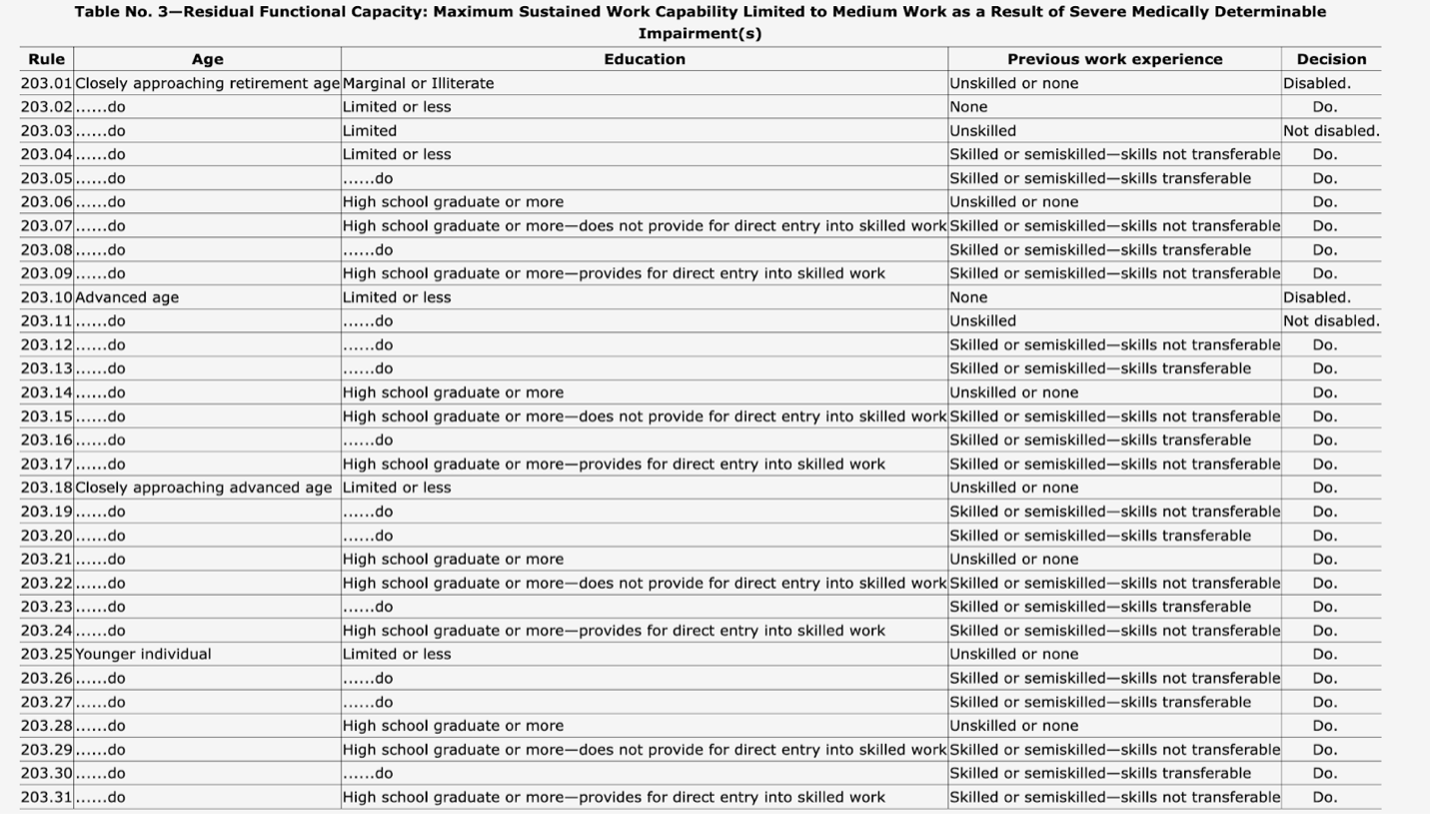
Tips for Navigating the GRID Rules
By following these tips, you can gain a better grasp of how the GRID Rules impact your SSDI application and improve your chances of approval.
- Know the key factors: The GRID Rules consider four main factors: your age, education level, work experience, and residual functional capacity. Understanding how these factors interact is crucial.
- Stay updated: The Social Security Administration may update the GRID Rules periodically. Stay informed about any changes that could impact your claim.
- Consult with a professional: If you are unsure how the GRID Rules will apply to your case, consider consulting with a disability lawyer. The GRID Rules are not intuitive and use complicated jargon. A disability attorney will review your case and explain how your medical-vocational profile may fit into the GRID Rules, arming you with the knowledge you need to be successful on a claim for disability.
Don’t let complex SSDI rules delay your benefits. Contact La Porte Law Firm today for expert guidance and a faster claim process.
FAQs
The SSA uses the GRID Rules to determine eligibility for disability benefits. These rules consider factors such as your age, education, work experience, and what kind of work you are capable of performing given your physical and mental impairments. Some GRID Rules direct a finding of “disabled” under Social Security regulations, and some direct a finding of “not disabled”.
Yes. Even if your medical-vocational profile does not direct a finding of “disabled” under the GRID Rules, your case could still be approved at step 5 of the sequential evaluation if your condition would prevent you from performing full-time work due to unscheduled absences or off-task behavior.
Age is a major factor in the GRID Rules. If you are aged 50–54, the SSA classifies you as “closely approaching advanced age.”If you’re aged 55–59, you are of “advanced age” under the GRID Rules. These profiles are easier to “grid favorably” because the SSA assumes it is more difficult to adjust to other work that is not related to past work. If you are a “younger individual” under the age of 50, the SSA considers that you have enough time in your career to pivot to another industry entirely.


